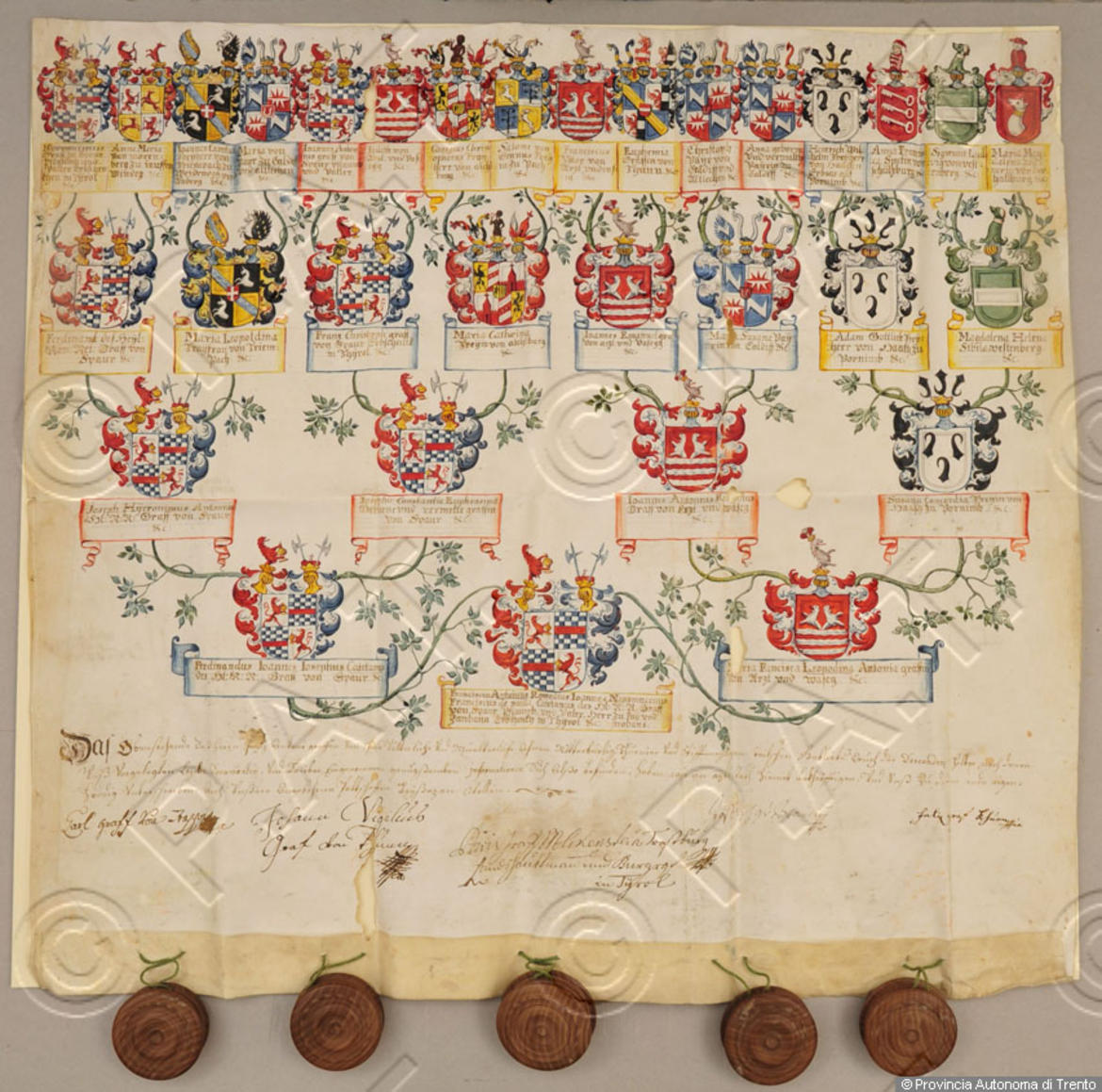The archive of the Counts Spaur of Castel Valer
The Autonomous Province of Trento has added an important set of documents to the public cultural heritage: the archive of the Counts Spaur of Castel Valer, consisting of about 1450 archival units.

In 2012 the Autonomous Province of Trento has added an important set of documents to the public cultural heritage: the archive of the Counts Spaur of Castel Valer.
This archive group was declared of great historical interest in 1964 because of the “large number of documents written on parchment and on paper from several centuries, regarding the history of Jurisdiction in Sporo, in the Val di Non, and extensively in Trentino”; it consists of about 1450 archival units, 619 of which on parchment, dating back the second half of the 13th century to the first half of the 20th century, for a total of about 15 linear metres of documentation.
The reference geographical area includes the areas of Tassullo, Flavon, Terres, Sporminore, the entire Val di Non, the Piana Rotaliana (Mezzocorona, Mezzolombardo, Zambana), the Paganella plateau (Spormaggiore, Molveno, Cavedago), the town of Trento, Termeno and Cortaccia, Val Venosta (Lagundo, Merano, Ciardes, Lichtenberg Castle), the town of Bolzano, and other areas of today’s Alto Adige, Tyrol, and Bavaria.
The oldest document dates back to 1231 (it was copied in 1317 and it concerns the investiture of the Bishop of Trento, Gerardo Oscasali), while the first original document dates back to 1285 (it concerns land purchasing in Molveno); both documents are not directly related to the Counts Spaur.
Below is a sort of review of content-based review - worth mentioning are: certificates of feudal rights dating from the 14th century, and in particular the investitures which the Counts Spaur received in relation to both Tyrolean feuds (Castel Rovina in Sporminore and jurisdiction of Spor, Castel Flavon and jurisdiction of Castel Flavon, Castel Valer, torre di Mezzocorona, tithes in Termeno; Lichtenberg Castle in Prato allo Stelvio, tithes in Merano, goods and rentals in Ciardes; feudal rights in Termeno) and to feuds attributable to the bishop of Trento (jurisdiction of Fai and Zambana, castle and farms of Mezzolombardo; feudal rights in Nave San Rocco, Zambana, Fai, tithes in Trodena, Carano, Mezzana, Roncio and Menas; goods in Cortaccia and a quarter of the tithe in Romallo).
Other documents are kept, though in limited quantities, concerning the jurisdictional and administrative functions of the “giudizio” (jurisdiction) of Spor, which since 1785 was unified in the so-called “giudizio” of Spor, Flavon and Belfort (notarial registers and dossiers of trial records from the first half of the 17th century to 1800).
Some local communities (Tassullo, Segno and Torra, Spormaggiore, Sporminore, Cavedago, Fai and Zambana, Mezzolombardo...) often appear as opposing party, for various reasons, to the Counts Spaur; some other times they produce themselves their own documents (“atti della regola delle Quattro Ville” - i.e. documents concerning the body of rules for the communities of Tassullo, Rallo, Pavillo and Sanzenone -, and a copy of the “carta di regola” for the communities of Fai and Zambana.
There are copious notary deeds (written both on parchment and on paper) and private documents concerning the management of the huge heritage of the Counts Spaur; they attest sales, lettings, part exchanges, census, receipts, value estimations, and transactions. There are also a lot of administrative and accounting records in so-called “urbari” and inventories of real and personal property; financial statements, expense accounts, lists of debts and credits.
There are also a lot of documents which - apart from implying obvious implications about heritage - are related to individuals’ biographical events, such as nuptial agreements, dowries, last wills and testaments, agreements in the field of marriage and estates, and more recently (since the 18th century), registry office certificates, genealogical charts and peerage evidences.
The list wouldn’t be complete without important sources about some members of the Spaur dinasty, which go beyond the family or genealogical sphere, depending on the office held and activities performed; it is the case of Volcmaro di Burgstall and Pietro Spaur.
Since the 18th and 19th centuries, the archive at issue reveals a broadening in terms of quantity and differentiation of information material; as a matter of fact, some new categories of sources emerge, such as those relating to education, exemplified by several samples of school notebooks, report cards and certificates.
Also worth mentioning is the rich collection of letters: more than 5,000 letters, dating back to the period between the 17th and 20th centuries, give a valuable insight into social, cultural and family life, which was often described by women.
At present time the archive is still being inventoried, but nonetheless it provides us with a detailed list which is accessible at the Provincial Archive Office of Trento; some documents, except for those of the 20th century, are also available in digital format.
01/12/2014

